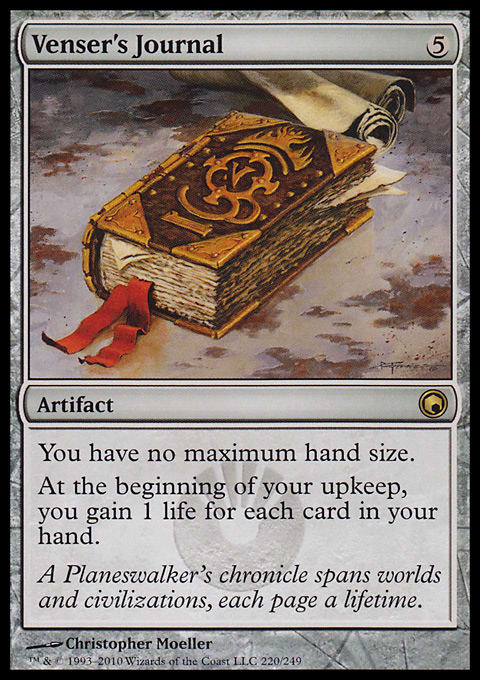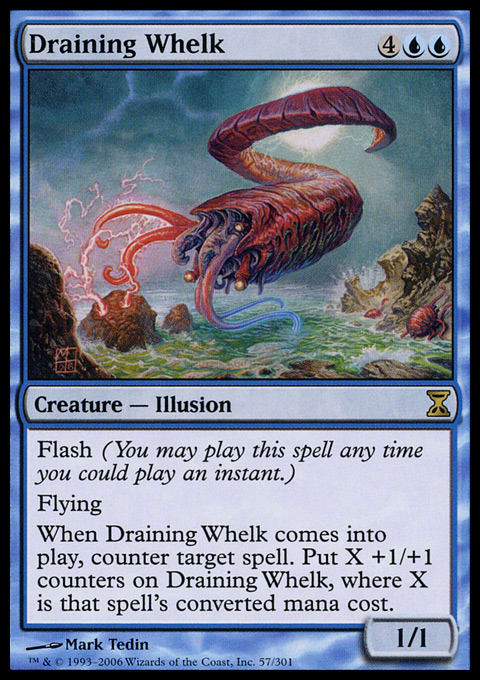To me, Commander is a game of proactive spells. I like casting (or building) huge creatures, putting together the pieces of a fun combo or synergy like a puzzle, or wrathing the board to keep someone else from pulling too far ahead. So I always approach blue, the most reactive of the colors, with some timidity; answers in the form of counterspells rather than kill spells, bounce instead of Wrath, and overcosted flyers or obscenely mana-hungry sea creatures (often with some crazy drawbacks) are not normally where I like to live.
But there’s a reason blue is pretty widely considered the strongest color in Magic. (Travis Woo has even said that Island is the strongest card in Magic.) It can draw absurd numbers of cards. Given time and enough resources, it can answer just about any threat, and it can control a game so the blue mage can win the game at his or her leisure. Let’s take those strengths and really, really lean on them. Let’s see what can happen when our commander’s size is determined by just how many cards we can draw.
Magic generally wants to limit us to seven cards in our hands, and normally, that’d be reasonable—with seven cards, we have a 7-power, flying commander, enough to dispatch a single opponent in just three hits. However, that assumes we use very few resources; if we hit a land drop, we can’t afford to cast any spells because we’ll wind up with an anemic hand and a very small Soramaro. There are ways to get around that—and we will—but first, as always, I like to cover the mana.
When I first set out to build this deck, I decided I wanted a giant Soramaro. I wanted him huge—one-shot-kill huge. But there’s no way to have twenty-one cards in hand when you swing without spending some mana, which meant I needed to build a deck that hit its land drops, played a lot of mana accelerators, and could afford to play spells and still have plenty of cards in hand. So don’t panic when you see there are forty lands and nine mana rocks. Drawing a lot of cards is expensive, so we’re going to want all the mana. Everflowing Chalice can be a real winner here, acting as a 2-mana or 8-mana accelerator, depending on where you are in the game and how much you need it, and Pristine Talisman gives you a boost and provides a little extra life, which adds up over a game. Coral Atoll taps for 2 mana and returns a land to your hand, making it awesome for this deck because a fifteen-card hand will stay a fifteen-card hand. Faerie Conclave and Halimar Depths each tap for
And we’ll need that limitless hand size. There are a solid ton of ways (seventeen) to draw cards in this deck. The nice thing is that most of them are redundant; you’ll play out one you draw, maybe you’ll play a second once you draw one that doesn’t tap, and the rest sit in your hand, making Soramaro even larger. We have a number of artifacts and creatures that tap to draw a card, such as Jayemdae Tome, Scepter of Insight, and Archivist. Then, we have the real all-stars, which are the ones that don’t require a tap, so we can pump all our mana into them to draw a ton of cards—and boost Soramaro along the way. Azure Mage, Sphinx of Magosi, Treasure Trove, and Diviner's Wand, when it’s equipped, all let us pour mana into cards. We have a bunch of ways to draw that require other means, such as Rhystic Study (remember the trigger!) and Seer's Sundial, which is great here because we always hit our land drops. Jace, Memory Adept is the most expensive card in the deck, but the +1 and ultimate abilities are both bonkers, and Planeswalkers will often draw attention to themselves and away from you. There are a couple of cards that care about Wizards: specifically Azami, Lady of Scrolls and Riptide Director. We have seven Wizards only, but they both simply tap for a card, which is good enough, and you’ll sometimes gain some extra with a random Trinket Mage. Mind Unbound is among my favorite cards in the game; most players have never thought about playing it, but when they see it come down on the other side of the table, they realize how bonkers it can be. Then, we have two game-breakers: Jushi Apprentice, when flipped, doubles the cards in your hand for 5 mana, and Blue Sun's Zenith can draw you X−3 cards (where X is how much mana you can make) at instant speed, turning it into a combat trick.
This much draw is going to be key not just to make our commander huge, but also because we really, really, really need to find a way to make our hand size limitless. There are five in the deck. Reliquary Tower is probably the best—it’s free, and most of the time, people won’t waste their Wastelands on it when someone else has Kessig Wolf Run or Urborg, Tomb of Yawgmoth. After that, Trinket Mage can search for either Spellbook (0 mana) or Library of Leng (1 mana, and which has the weird but useful side effect of protecting you from discard, even from Syphon Mind or Nath of the Gilt-Leaf). Venser's Journal is expensive but will gain you a bunch of life. Last and probably least, Graceful Adept is a Spellbook on a stick. A key to this deck is only playing one of these at a time. Hold the rest in your hand to both add to your hand count and protect this ability—when someone Shatterstorms, you don’t want to lose three of your five ways to keep your hand above seven cards.
We have a few other giant beaters here that help lock things down and can do some damage on their own. Along with the aforementioned Sphinx of Magosi, Sphinx Ambassador and Windreader Sphinx can do a lot of damage by themselves—try stealing ramp spells from a green mage with the Ambassador or suiting up Windreader with Diviner's Wand. Diluvian Primordial and Chancellor of the Spires are both solid blue beaters with a bunch of extra value tacked on. The recently reprinted Stormtide Leviathan will simply require an answer—when he (she? it?) and our commander can both attack as they wish and lock down most of the other creatures in the game, it will create a rush to remove it. Chasm Skulker should speak for itself, but in this deck, it probably can’t with its maw full of your opponents. Even if it dies, it’ll probably leave you with a formidable group of Squids.
Counterpells are blue’s strongest way of dealing with otherwise brutal threats. In multiplayer, though, it’s important we think very carefully about when to deploy them. We want to save our Rewind, our Dissipate, and our Draining Whelk for when we see there is no way to win the game if the enemy spell resolves. Hold Dissolve, Cancel, and Stoic Rebuttal (which is often
There are four pieces of Equipment in the deck that will give Soramaro trample: Sword of Vengeance, Vorrac Battlehorns, Chariot of Victory, and Loxodon Warhammer. Rogue's Passage might be better, but giving trample to a 28/28 flyer will often get the job done on its own. Trailblazer's Boots also makes Soramaro close to unblockable—rare is the Commander deck with zero nonbasic lands.
Soramaro, First to Dream ? Commander | Mark Wischkaemper
- Commander (0)
- Creatures (14)
- 1 Archivist
- 1 Azure Mage
- 1 Chancellor of the Spires
- 1 Diluvian Primordial
- 1 Draining Whelk
- 1 Graceful Adept
- 1 Jushi Apprentice
- 1 Riptide Director
- 1 Sphinx Ambassador
- 1 Sphinx of Magosi
- 1 Stormtide Leviathan
- 1 Trinket Mage
- 1 Windreader Sphinx
- 1 Azami, Lady of Scrolls
- Planeswalkers (1)
- 1 Jace, Memory Adept
- Spells (44)
- 1 Blue Sun's Zenith
- 1 Cancel
- 1 Counterspell
- 1 Cut the Earthly Bond
- 1 Dismiss
- 1 Dissipate
- 1 Dissolve
- 1 Evacuation
- 1 Polymorphist's Jest
- 1 Pongify
- 1 Rewind
- 1 Spelljack
- 1 Stoic Rebuttal
- 1 Turn to Frog
- 1 Curse of the Swine
- 1 Inundate
- 1 Void Snare
- 1 Whelming Wave
- 1 Mind Unbound
- 1 Rhystic Study
- 1 Treasure Trove
- 1 Brittle Effigy
- 1 Chariot of Victory
- 1 Chronatog Totem
- 1 Darksteel Ingot
- 1 Everflowing Chalice
- 1 Guardian Idol
- 1 Jayemdae Tome
- 1 Library of Leng
- 1 Loxodon Warhammer
- 1 Mind Stone
- 1 Pristine Talisman
- 1 Scepter of Insight
- 1 Seer's Sundial
- 1 Sisay's Ring
- 1 Sky Diamond
- 1 Spellbook
- 1 Star Compass
- 1 Sword of Vengeance
- 1 Trailblazer's Boots
- 1 Venser's Journal
- 1 Vorrac Battlehorns
- 1 Diviner's Wand
- 1 Bident of Thassa
- Lands (40)
- 30 Island
- 1 Coral Atoll
- 1 Evolving Wilds
- 1 Faerie Conclave
- 1 Halimar Depths
- 1 Lonely Sandbar
- 1 Mystifying Maze
- 1 Reliquary Tower
- 1 Remote Isle
- 1 Rogue's Passage
- 1 Terramorphic Expanse
I almost included O-Naginata in this list, but I decided the deck draws so many cards that more redundancy on additional evasion wasn’t worth the spot. Ur-Golem's Eye is a functional reprint of Sisay's Ring, but one 4-mana accelerator was enough. Illuminated Folio is among my favorite ways to draw cards in a mono-colored deck, but I liked Jace more at the 5-spot. I also toyed with some of the everyone-gets-a-card effects like Howling Mine and Temple Bell, but we don’t need to do that in blue, so why help our opponents? Discombobulate and Lay Bare were both perfectly acceptable counters, but ultimately, I felt nine was the right number. If your metagame has a lot of haymakers or too much combo, you might want to force those in; I’d probably cut Bident of Thassa and Sword of Vengeance for them.
Have a little more cash? Force of Will and Mana Drain would both be absurd in this deck, as would a Mind's Eye. Sol Ring and Ancient Tomb could replace Star Compass and an Island.
Soramaro, First to Dream will catch a lot of opponents off-guard. It draws a startling number of cards, and it does so with great reliability. Always play your land for turn and run out your first few pieces of acceleration, and even when he dies, you’ll be able to recast him as a huge monster—assuming you don’t just counter the opponent’s removal spell.
Total cost: $64.26





























